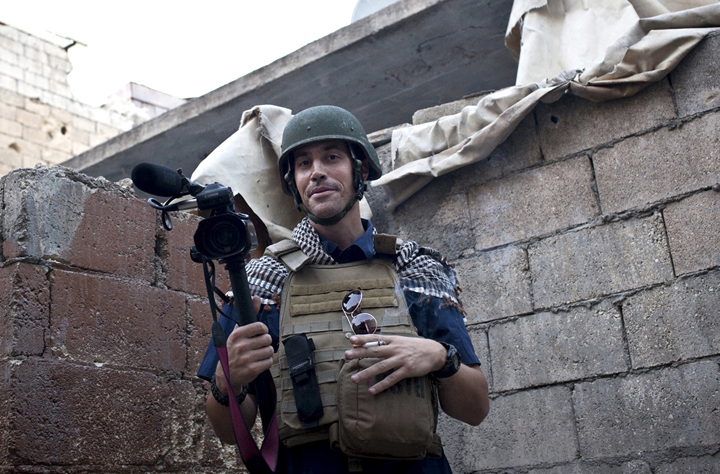With the brutal murder of U.S. freelance journalist James Foley this week, there have been at least 32 journalists killed so far in 2014, according to the Committee to Protect Journalists (CPJ).

Journalists such as Simone Camilli, a video journalist for The Associated Press, were killed covering conflicts, but others, such as veteran AP photographer Anja Niedringhaus and French photojournalist Camille Lepage, were the victims of attacks — murdered while doing the job they loved.
Syria, where 40-year-old Foley was beheaded on video by an Islamic State militant after being held captive for 21 months, is now considered the most dangerous place on earth to be a journalist with six journalists killed on the job so far this year, CPJ reported.
READ MORE: James Foley – Risking life to make sure conflicts don’t go unreported
Here’s a look at the careers of some of the journalists who lost their lives in 2014.
James Foley, killed in Syria
Foley was no stranger to covering conflict or working in risky conditions. Working as freelancer and filing stories for organizations such as Agence France-Press and online news organization GlobalPost, he was kidnapped by forces loyal to the Libyan government and held captive for 44 days.
GlobalPost described Foley this way:
Jim cared deeply about the victims of war, and the rights of people living under oppressive regimes. He was an old-school reporter, who traveled light, talked to the locals and put the story first.
For GlobalPost, Foley published in-depth coverage of the battle to oust late-Libyan dictator Moammar Gadhafi and detailing “a Libya that was rarely seen and little understood,” as well as his experience in captivity.
READ MORE: Remembering James Foley
The ordeal in Libya didn’t prevent Foley from continuing his work and going on to file from Iraq and finally Syria.
Below are images from video Foley captured while covering the Syrian civil war in August 2012, three months before his capture.
Anja Niedringhaus, killed in Afghanistan

German photographer Anja Niedringhaus was travelling in a convoy along with Canadian AP reporter Kathy Gannon on April 4, covering preparations for the presidential election that weekend, when an Afghan policeman opened fire on their vehicle with an AK-47. Gannon suffered injuries from three gunshot wounds, but Niedringhaus was killed instantly. She was 48
SEE ALSO: 15 images from AP photojournalist Anja Niedringhaus’ career
Camille Lepage, killed in Central African Republic
Camille Lepage was just 26 years old when she shot and killed in the Central African Republic, where she had been covering the conflict between Muslim and Christian fighters.

She had been embedded with Christian anti-Balaka fighters, who were battling former Selaka rebels: both groups were responsible for the deaths of more than 2,400 people, in scenes often reminiscent of the genocide in Rwanda.
Lepage was travelling with the anti-Balaka near the border with Cameroon when she was killed, in an apparent ambush. Her body was found by French peacekeepers on May 13. She also covered the conflict and humanitarian crisis in South Sudan. Her work had been published by the Guardian, the Wall Street Journal and the BBC, among others.
SEE MORE: The acclaimed work of slain photojournalist Camille Lepage
Simone Camilli, killed in the Gaza Strip
Italian videojournalist Simone Camilli was working for AP in the Gaza Strip when he was killed in an explosion, along with his Palestinian translator, on Aug 13.
According to The Associated Press, Camilli died in a blast in the town of Beit Lahiya as Gaza police engineers tried “to diffuse unexploded ordnance fired by Israel,” during the Israeli military operation against Hamas
The 35-year-old had worked for the news agency since 2005 and had been based in the Middle East since 2006. He regularly worked in the Gaza Strip.
READ MORE: AP video journalist Simone Camilli killed in Gaza explosion
“His video had a signature, an incredible eye for detail and was able to personalize stories and portray human drama,” AP’s Tomislav Skaro told TIME magazine.
The publication posted video from a multimedia project Camilli was working on before his death — portraying Israel’s 2009 offensive in the Gaza Strip, known as Operation Cast Lead.
With files from The Associated Press
- Canada refused to repatriate woman from ISIS camp because she can’t be arrested: internal memo
- Spain’s PM considers resigning amid wife’s legal probe: ‘Is it all worth it?’
- Russia vetoes UN resolution to prevent nuclear arms race in space
- Is Trump immune in the 2020 election case? What to watch for during hearing












Comments